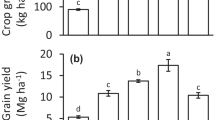Summary
Two municipal sludges, one from a highly industrialized city, Chicago, Il, and another from a little industrialized, highly agricultural area, Tucson, AZ are compared for winter barley production on Pima c 1 (Typic torrifluvent). Both sludges were responsible for highly significant additions of Zn, Cu, Ni, Cd and P to the soil each year when applied at the rates of 100 mt/ha singly and 20 mt/ha each year for 4 years. Nitrogen responses for barley straw and grain were observed from both sludges. Tucson sludge appears to be attractive as a potential fertilizer, not only as an NPK source, but also for its organic matter and minimal amounts of heavy metals. The Chicago sludge with relatively high levels of heavy metals, particularly Cd, appears poorly suited as a fertilizer, if used for an extended period of time, because of the plant's tendency to take up elevated levels of certain heavy metals. Some parts of barley plants proved to be a better indicator of heavy metal uptake and concentration than others. The diagnostic-tissue test promises to be a useful tool to warn against undesirable accumulation of heavy metals. Fortunately, when compared with other plant parts, the heavy metal in grain was the least altered as a result of continued sewage sludge use on arid land. The soil's neutral to slightly alkaline pH and the presence of lime throughout the soil profile appeared to be critical factors in keeping plant uptake of heavy metals relatively low as compared with soils of other climates.
Similar content being viewed by others
References
Jones Jr J B, Large R L, Pfleiderer D B and Klosky H S 1971 How to properly sample for plant analysis. Crop Soils 23, 15–18.
Large C E 1954 Growth stage of cereals: II Illustration of the Freekes Scale. Plant Pathol. 3, 128–129.
Page A L, Miller R H and Keeney D R 1982 Methods of soil analysis. Part 2 Chemical and Microbial properties, 2nd Ed. Am. Soc. Agron. Madison, WI.
Watson J E, Pepper I L, Unger M and Fuller W H 1985 Yield and leaf element composition of cotton grown on sludge amended soil. J. Environ. Qual. 14, 174–177.
Author information
Authors and Affiliations
Rights and permissions
About this article
Cite this article
Unger, M., Fuller, W.H. Optimum utilization of sewage sludge of low and high metal content for grain production on arid lands. Plant Soil 88, 321–332 (1985). https://doi.org/10.1007/BF02197489
Received:
Revised:
Issue Date:
DOI: https://doi.org/10.1007/BF02197489




